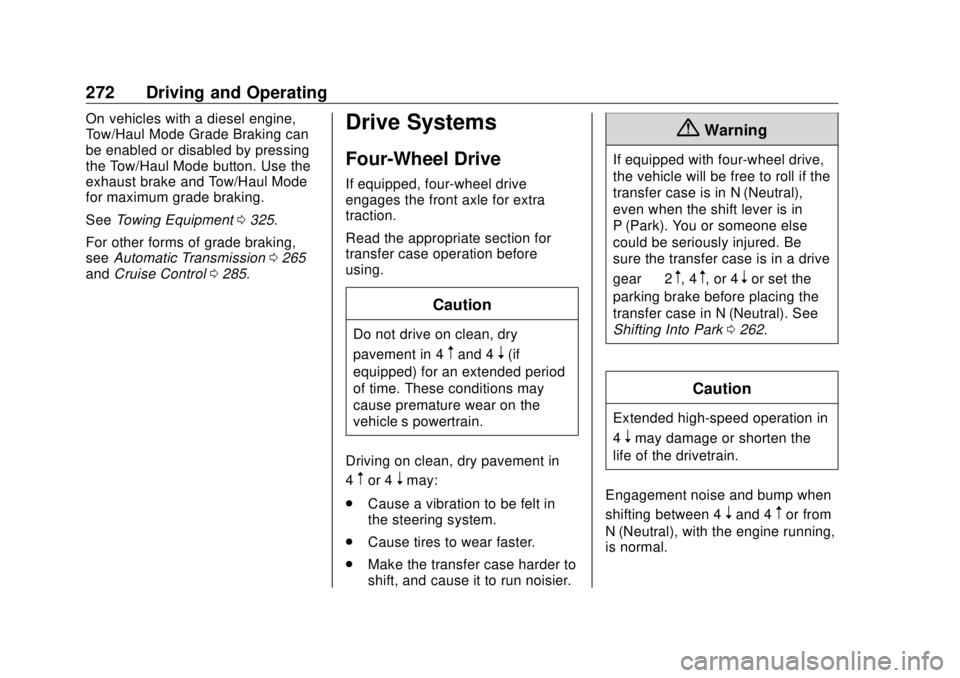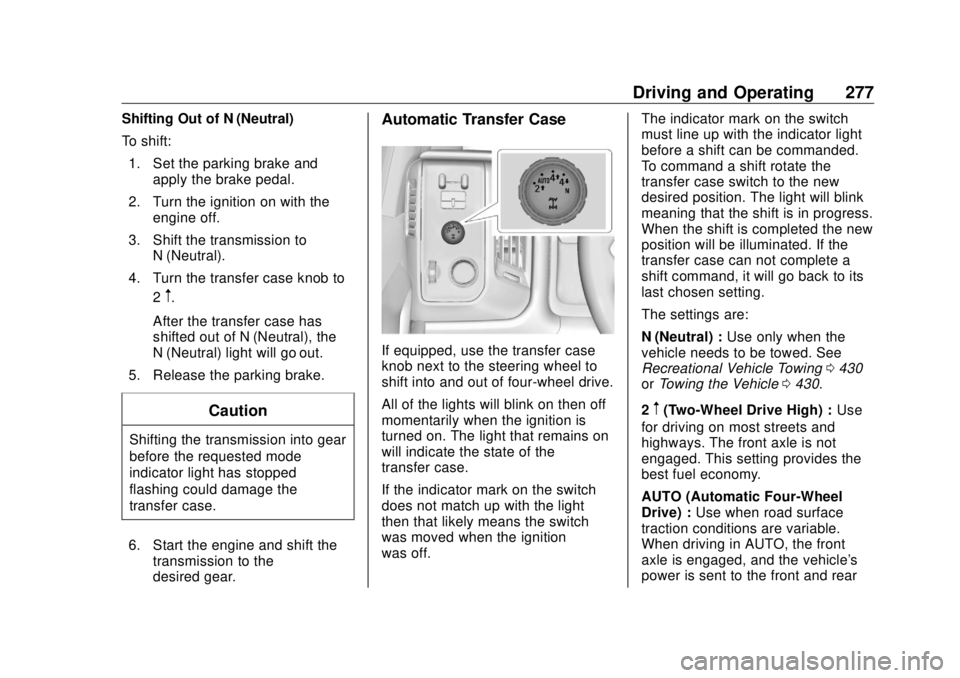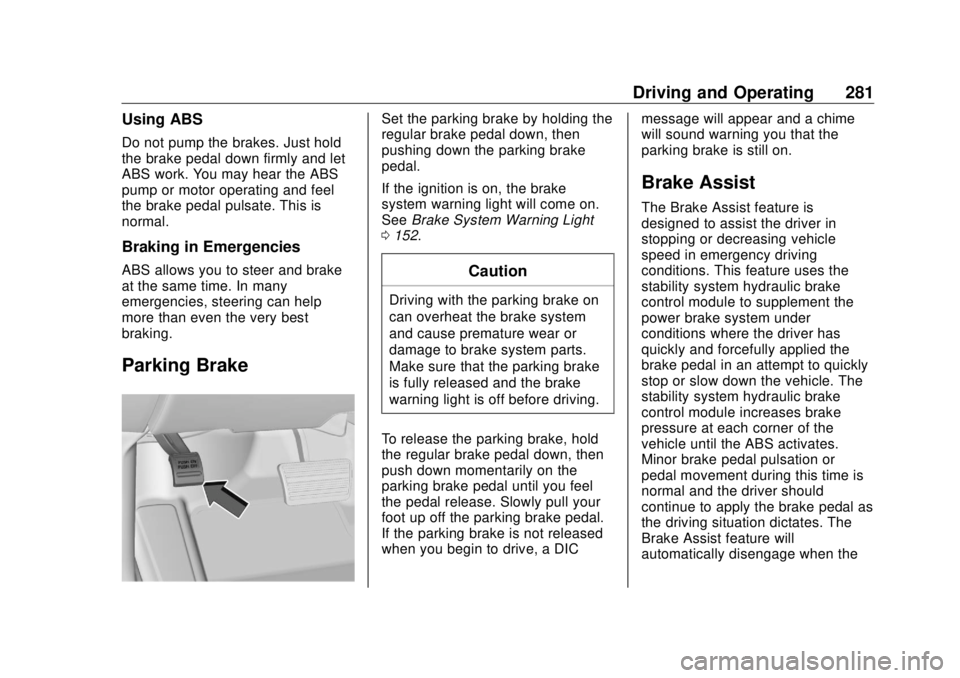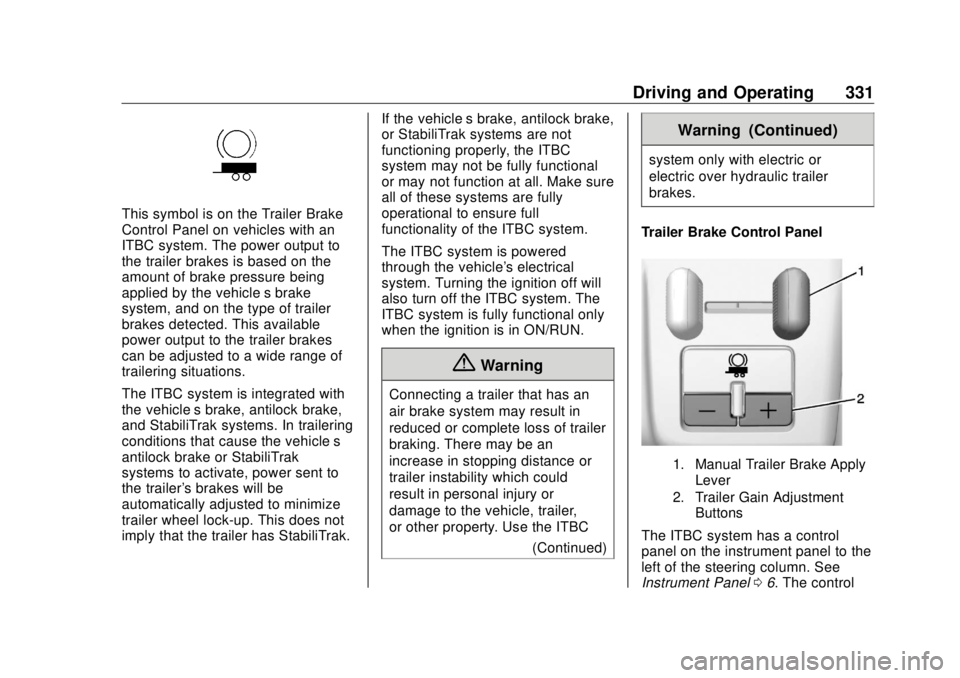2018 GMC SIERRA DENALI power steering
[x] Cancel search: power steeringPage 273 of 505

GMC Sierra/Sierra Denali Owner Manual (GMNA-Localizing-U.S./Canada/
Mexico-11349177) - 2018 - CRC - 10/17/17
272 Driving and Operating On vehicles with a diesel engine,
Tow/Haul Mode Grade Braking can
be enabled or disabled by pressing
the Tow/Haul Mode button. Use the
exhaust brake and Tow/Haul Mode
for maximum grade braking.
See Towing Equipment 0 325 .
For other forms of grade braking,
see Automatic Transmission 0 265
and Cruise Control 0 285 .
Drive Systems Four-Wheel Drive If equipped, four-wheel drive
engages the front axle for extra
traction.
Read the appropriate section for
transfer case operation before
using.
CautionDo not drive on clean, dry
pavement in 4
m and 4
n (if
equipped) for an extended period
of time. These conditions may
cause premature wear on the
vehicle ’ s powertrain.
Driving on clean, dry pavement in
4
m or 4
n may:
.
Cause a vibration to be felt in
the steering system.
.
Cause tires to wear faster.
.
Make the transfer case harder to
shift, and cause it to run noisier. { WarningIf equipped with four-wheel drive,
the vehicle will be free to roll if the
transfer case is in N (Neutral),
even when the shift lever is in
P (Park). You or someone else
could be seriously injured. Be
sure the transfer case is in a drive
gear — 2
m , 4
m , or 4
n or set the
parking brake before placing the
transfer case in N (Neutral). See
Shifting Into Park 0 262 .
Caution
Extended high-speed operation in
4
n may damage or shorten the
life of the drivetrain.
Engagement noise and bump when
shifting between 4
n and 4
m or from
N (Neutral), with the engine running,
is normal.
Page 278 of 505

GMC Sierra/Sierra Denali Owner Manual (GMNA-Localizing-U.S./Canada/
Mexico-11349177) - 2018 - CRC - 10/17/17
Driving and Operating 277Shifting Out of N (Neutral)
To shift:
1. Set the parking brake and
apply the brake pedal.
2. Turn the ignition on with the
engine off.
3. Shift the transmission to
N (Neutral).
4. Turn the transfer case knob to
2
m .
After the transfer case has
shifted out of N (Neutral), the
N (Neutral) light will go out.
5. Release the parking brake.
Caution
Shifting the transmission into gear
before the requested mode
indicator light has stopped
flashing could damage the
transfer case.
6. Start the engine and shift the
transmission to the
desired gear. Automatic Transfer Case
If equipped, use the transfer case
knob next to the steering wheel to
shift into and out of four-wheel drive.
All of the lights will blink on then off
momentarily when the ignition is
turned on. The light that remains on
will indicate the state of the
transfer case.
If the indicator mark on the switch
does not match up with the light
then that likely means the switch
was moved when the ignition
was off. The indicator mark on the switch
must line up with the indicator light
before a shift can be commanded.
To command a shift rotate the
transfer case switch to the new
desired position. The light will blink
meaning that the shift is in progress.
When the shift is completed the new
position will be illuminated. If the
transfer case can not complete a
shift command, it will go back to its
last chosen setting.
The settings are:
N (Neutral) : Use only when the
vehicle needs to be towed. See
Recreational Vehicle Towing 0 430
or Towing the Vehicle 0 430 .
2
m (Two-Wheel Drive High) : Use
for driving on most streets and
highways. The front axle is not
engaged. This setting provides the
best fuel economy.
AUTO (Automatic Four-Wheel
Drive) : Use when road surface
traction conditions are variable.
When driving in AUTO, the front
axle is engaged, and the vehicle's
power is sent to the front and rear
Page 282 of 505

GMC Sierra/Sierra Denali Owner Manual (GMNA-Localizing-U.S./Canada/
Mexico-11349177) - 2018 - CRC - 10/17/17
Driving and Operating 281Using ABS Do not pump the brakes. Just hold
the brake pedal down firmly and let
ABS work. You may hear the ABS
pump or motor operating and feel
the brake pedal pulsate. This is
normal.
Braking in Emergencies ABS allows you to steer and brake
at the same time. In many
emergencies, steering can help
more than even the very best
braking.
Parking Brake Set the parking brake by holding the
regular brake pedal down, then
pushing down the parking brake
pedal.
If the ignition is on, the brake
system warning light will come on.
See Brake System Warning Light
0 152 .
CautionDriving with the parking brake on
can overheat the brake system
and cause premature wear or
damage to brake system parts.
Make sure that the parking brake
is fully released and the brake
warning light is off before driving.
To release the parking brake, hold
the regular brake pedal down, then
push down momentarily on the
parking brake pedal until you feel
the pedal release. Slowly pull your
foot up off the parking brake pedal.
If the parking brake is not released
when you begin to drive, a DIC message will appear and a chime
will sound warning you that the
parking brake is still on.
Brake Assist The Brake Assist feature is
designed to assist the driver in
stopping or decreasing vehicle
speed in emergency driving
conditions. This feature uses the
stability system hydraulic brake
control module to supplement the
power brake system under
conditions where the driver has
quickly and forcefully applied the
brake pedal in an attempt to quickly
stop or slow down the vehicle. The
stability system hydraulic brake
control module increases brake
pressure at each corner of the
vehicle until the ABS activates.
Minor brake pedal pulsation or
pedal movement during this time is
normal and the driver should
continue to apply the brake pedal as
the driving situation dictates. The
Brake Assist feature will
automatically disengage when the
Page 332 of 505

GMC Sierra/Sierra Denali Owner Manual (GMNA-Localizing-U.S./Canada/
Mexico-11349177) - 2018 - CRC - 10/17/17
Driving and Operating 331
This symbol is on the Trailer Brake
Control Panel on vehicles with an
ITBC system. The power output to
the trailer brakes is based on the
amount of brake pressure being
applied by the vehicle ’ s brake
system, and on the type of trailer
brakes detected. This available
power output to the trailer brakes
can be adjusted to a wide range of
trailering situations.
The ITBC system is integrated with
the vehicle ’ s brake, antilock brake,
and StabiliTrak systems. In trailering
conditions that cause the vehicle ’ s
antilock brake or StabiliTrak
systems to activate, power sent to
the trailer's brakes will be
automatically adjusted to minimize
trailer wheel lock-up. This does not
imply that the trailer has StabiliTrak. If the vehicle ’ s brake, antilock brake,
or StabiliTrak systems are not
functioning properly, the ITBC
system may not be fully functional
or may not function at all. Make sure
all of these systems are fully
operational to ensure full
functionality of the ITBC system.
The ITBC system is powered
through the vehicle's electrical
system. Turning the ignition off will
also turn off the ITBC system. The
ITBC system is fully functional only
when the ignition is in ON/RUN.
{ WarningConnecting a trailer that has an
air brake system may result in
reduced or complete loss of trailer
braking. There may be an
increase in stopping distance or
trailer instability which could
result in personal injury or
damage to the vehicle, trailer,
or other property. Use the ITBC
(Continued) Warning (Continued) system only with electric or
electric over hydraulic trailer
brakes.
Trailer Brake Control Panel
1. Manual Trailer Brake Apply
Lever
2. Trailer Gain Adjustment
Buttons
The ITBC system has a control
panel on the instrument panel to the
left of the steering column. See
Instrument Panel 0 6 . The control
Page 342 of 505

GMC Sierra/Sierra Denali Owner Manual (GMNA-Localizing-U.S./Canada/
Mexico-11349177) - 2018 - CRC - 10/17/17
Vehicle Care 341
Vehicle Care General Information General Information . . . . . . . . . . 342
California Proposition
65 Warning . . . . . . . . . . . . . . . . . 343
California Perchlorate
Materials Requirements . . . . . 343
Accessories and
Modifications . . . . . . . . . . . . . . . . 343
Vehicle Checks Doing Your Own
Service Work . . . . . . . . . . . . . . . 344
Hood . . . . . . . . . . . . . . . . . . . . . . . . . 344
Engine Compartment
Overview . . . . . . . . . . . . . . . . . . . . 345
Engine Oil . . . . . . . . . . . . . . . . . . . . 350
Engine Oil Life System . . . . . . . 353
Automatic Transmission Fluid
(6-Speed Transmission) . . . . . 354
Automatic Transmission Fluid
(8-Speed Transmission) . . . . . 357
Engine Air Cleaner/Filter . . . . . . 358
Cooling System . . . . . . . . . . . . . . 359
Engine Overheating . . . . . . . . . . 363
Overheated Engine Protection
Operating Mode . . . . . . . . . . . . . 364
Engine Fan . . . . . . . . . . . . . . . . . . . 365 Power Steering Fluid (1500
Series) . . . . . . . . . . . . . . . . . . . . . . 365
Power Steering Fluid (2500/
3500 Series) . . . . . . . . . . . . . . . . 365
Washer Fluid . . . . . . . . . . . . . . . . . 366
Brakes . . . . . . . . . . . . . . . . . . . . . . . 367
Brake Fluid . . . . . . . . . . . . . . . . . . . 368
Battery - North America . . . . . . 369
Four-Wheel Drive . . . . . . . . . . . . . 370
Front Axle . . . . . . . . . . . . . . . . . . . . 370
Rear Axle . . . . . . . . . . . . . . . . . . . . 371
Noise Control System . . . . . . . . 373
Starter Switch Check . . . . . . . . . 374
Automatic Transmission Shift
Lock Control Function
Check . . . . . . . . . . . . . . . . . . . . . . . 374
Ignition Transmission Lock
Check . . . . . . . . . . . . . . . . . . . . . . . 374
Park Brake and P (Park)
Mechanism Check . . . . . . . . . . 375
Wiper Blade Replacement . . . . 375
Windshield Replacement . . . . . 376
Gas Strut(s) . . . . . . . . . . . . . . . . . . 376
Headlamp Aiming Headlamp Aiming . . . . . . . . . . . . 377
Bulb Replacement
Bulb Replacement . . . . . . . . . . . . 378
Halogen Bulbs . . . . . . . . . . . . . . . . 378 High Intensity Discharge (HID)
Lighting . . . . . . . . . . . . . . . . . . . . . 378
LED Lighting . . . . . . . . . . . . . . . . . 378
Taillamps, Turn Signal,
Stoplamps, and Back-Up
Lamps . . . . . . . . . . . . . . . . . . . . . . 378
Center High-Mounted
Stoplamp (CHMSL) and
Cargo Lamp . . . . . . . . . . . . . . . . . 380
Electrical System High Voltage Devices and
Wiring . . . . . . . . . . . . . . . . . . . . . . . 380
Electrical System Overload . . . 380
Fuses and Circuit Breakers . . . 381
Engine Compartment Fuse
Block . . . . . . . . . . . . . . . . . . . . . . . . 381
Instrument Panel Fuse Block
(Right) . . . . . . . . . . . . . . . . . . . . . . 385
Instrument Panel Fuse
Block (Left) . . . . . . . . . . . . . . . . . 386
Wheels and Tires Tires . . . . . . . . . . . . . . . . . . . . . . . . . . 389
All-Season Tires . . . . . . . . . . . . . . 389
Winter Tires . . . . . . . . . . . . . . . . . . 390
Low-Profile Tires . . . . . . . . . . . . . 390
All-Terrain Tires . . . . . . . . . . . . . . . 391
Tire Sidewall Labeling . . . . . . . . 391
Tire Designations . . . . . . . . . . . . . 393
Page 351 of 505

GMC Sierra/Sierra Denali Owner Manual (GMNA-Localizing-U.S./Canada/
Mexico-11349177) - 2018 - CRC - 10/17/17
350 Vehicle Care 1. Positive (+) Terminal. See
Jump Starting - North America
0 426 .
2. Battery - North America 0 369 .
3. Coolant Surge Tank and
Pressure Cap. See Cooling
System 0 359 .
4. Engine Air Cleaner/Filter 0 358 .
5. Automatic Transmission
Dipstick (If Equipped). See
“ How to Check Automatic
Transmission Fluid ” under
Automatic Transmission Fluid
(6-Speed Transmission) 0 354
or Automatic Transmission
Fluid (8-Speed Transmission)
0 357 .
6. Engine Oil Dipstick. See
“ Checking Engine Oil ” under
Engine Oil 0 350 .
7. Engine Oil Fill Cap. See “ When
to Add Engine Oil ” under
Engine Oil 0 350 .
8. Engine Cooling Fan (Out of
View). See Cooling System
0 359 . 9. Remote Negative ( – ) Location.
See Jump Starting - North
America 0 426 .
10. Power Steering Fluid
Reservoir. See Power Steering
Fluid (1500 Series) 0 365 or
Power Steering Fluid (2500/
3500 Series) 0 365 .
11. Windshield Washer Fluid
Reservoir. See “ Adding Washer
Fluid ” under Washer Fluid
0 366 .
12. Brake Fluid Reservoir. See
Brake Fluid 0 368 .
13. Auxiliary Battery (If Equipped).
See Battery - North America
0 369 .
14. Engine Compartment Fuse
Block 0 381 .
If the vehicle has a diesel engine
and/or an Allison Transmission, see
the Duramax diesel supplement.
For an eAssist vehicle, see the
Silverado/Sierra supplement. Engine Oil For diesel engine vehicles, see
“ Engine Oil ” in the Duramax diesel
supplement.
To ensure proper engine
performance and long life, careful
attention must be paid to engine oil.
Following these simple, but
important steps will help protect
your investment:
.
Use engine oil approved to the
proper specification and of the
proper viscosity grade. See
“ Selecting the Right Engine Oil ”
in this section.
.
Check the engine oil level
regularly and maintain the
proper oil level. See “ Checking
Engine Oil ” and “ When to Add
Engine Oil ” in this section.
.
Change the engine oil at the
appropriate time. See Engine Oil
Life System 0 353 .
.
Always dispose of engine oil
properly. See “ What to Do with
Used Oil ” in this section.
Page 366 of 505

GMC Sierra/Sierra Denali Owner Manual (GMNA-Localizing-U.S./Canada/
Mexico-11349177) - 2018 - CRC - 10/17/17
Vehicle Care 365Caution (Continued)attempting any repair. Repair the
cause of coolant loss, change the
oil, and reset the oil life system.
See Engine Oil 0 350 .
Engine Fan If the vehicle has a clutched engine
cooling fan, when the clutch is
engaged, the fan spins faster to
provide more air to cool the engine.
In most everyday driving conditions,
the fan is spinning slower and the
clutch is not fully engaged. This
improves fuel economy and reduces
fan noise. Under heavy vehicle
loading, trailer towing, and/or high
outside temperatures, the fan speed
increases as the clutch more fully
engages, so an increase in fan
noise may be heard. This is normal
and should not be mistaken as the
transmission slipping or making
extra shifts. It is merely the cooling
system functioning properly. The fan will slow down when additional
cooling is not required and the
clutch disengages.
This fan noise may also be heard
when starting the engine. It will go
away as the fan clutch partially
disengages.
If the vehicle has electric cooling
fan(s), the fans may be heard
spinning at low speed during most
everyday driving. The fans may turn
off if no cooling is required. Under
heavy vehicle loading, trailer towing,
high outside temperatures,
or operation of the air conditioning
system, the fans may change to
high speed and an increase in fan
noise may be heard. This is normal
and indicates that the cooling
system is functioning properly. The
fans will change to low speed when
additional cooling is no longer
required.
The electric engine cooling fans
may run after the engine has been
turned. off. This is normal and no
service is required. Power Steering Fluid
(1500 Series) The vehicle has electric power
steering and does not use power
steering fluid.
Power Steering Fluid
(2500/3500 Series)
See Engine Compartment Overview
0 345 for reservoir location.
When to Check Power Steering
Fluid It is not necessary to regularly
check power steering fluid unless
there is a leak suspected in the
system or an unusual noise is
heard. A fluid loss in this system
could indicate a problem. Have the
system inspected and repaired.
Page 367 of 505

GMC Sierra/Sierra Denali Owner Manual (GMNA-Localizing-U.S./Canada/
Mexico-11349177) - 2018 - CRC - 10/17/17
366 Vehicle Care Wait for the power steering system
to cool, with the engine off, before
checking the fluid.
How to Check Power Steering
Fluid To check the power steering fluid:
1. Turn the ignition off and let the
engine compartment
cool down.
2. Wipe the cap and the top of the
reservoir clean.
3. Unscrew the cap and wipe the
dipstick with a clean rag.
4. Replace the cap and
completely tighten it.
5. Remove the cap again and
look at the fluid level on the
dipstick.
The level should be between the
ADD and FULL marks. If necessary,
add only enough fluid to bring the
level up to the hashed area between
the ADD and FULL marks. What to Use To determine what kind of fluid to
use, see Recommended Fluids and
Lubricants 0 456 . Always use the
proper fluid.
CautionUse of the incorrect fluid may
damage the vehicle and the
damages may not be covered by
the vehicle warranty. Always use
the correct fluid listed in
Recommended Fluids and
Lubricants 0 456 .
Washer Fluid What to Use When windshield washer fluid needs
to be added, be sure to read the
manufacturer's instructions before
use. Use a fluid that has sufficient
protection against freezing in an
area where the temperature may fall
below freezing. Adding Washer Fluid The vehicle has a low washer fluid
message on the DIC that comes on
when the washer fluid is low. The
message is displayed for
15 seconds at the start of each
ignition cycle. When the WASHER
FLUID LOW ADD FLUID message
displays, washer fluid will need to
be added to the windshield washer
fluid reservoir.
Open the cap with the washer
symbol on it. Add washer fluid until
the tank is full. See Engine
Compartment Overview 0 345 for
reservoir location.